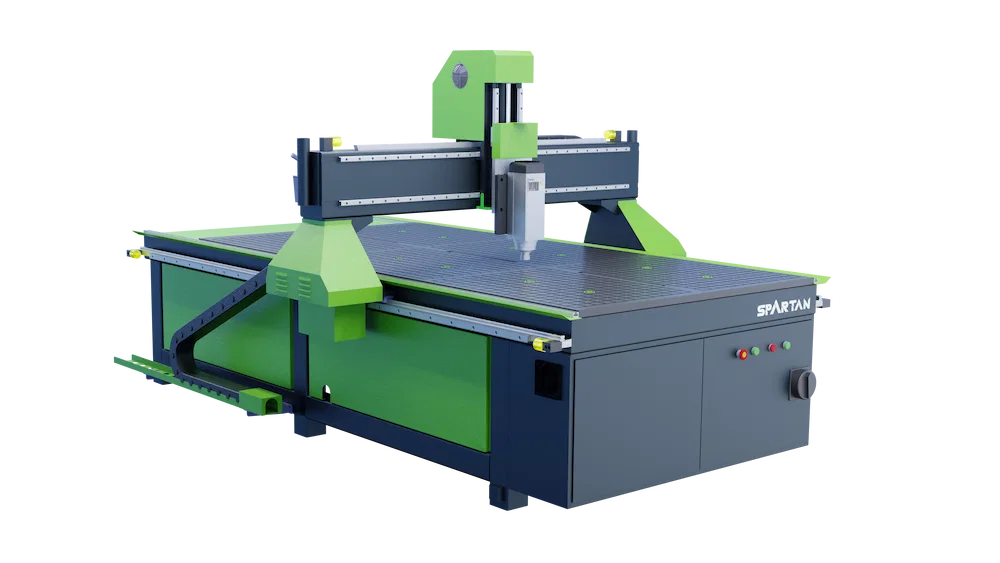Unlocking Creativity: A Beginner’s Guide to CNC Routers and Their Endless Possibilities

If you’ve ever dreamed of designing intricate carvings, custom furniture, or personalised gifts, this beginner’s guide will illuminate the path towards mastering CNC technology. We’ll demystify the fundamentals of CNC routers while providing you with practical tips and insights to unlock your creative potential.
We explore the fascinating features, essential tools, and innovative applications that make CNC routers a game-changer in the creative landscape. With the right guidance, you’ll find that the only limit is your imagination!

What is a CNC Router?
This technology eliminates the need for human intervention during the cutting process, ensuring consistent, accurate, and repeatable results every time. These routers can handle a variety of materials, including wood, plastic, aluminium, and even foam, making them versatile tools in numerous industries.
The concept behind CNC routers is relatively straightforward. By translating a digital design into machine commands, the router follows a predetermined path to cut, carve, or engrave the material. This process is akin to a highly accurate and automated sculptor, working tirelessly to bring your digital designs to life. For beginners, understanding the fundamental operation of a CNC router is crucial, as it lays the foundation for more advanced projects and applications.
In addition to their precision, CNC routers are celebrated for their ability to replicate complex designs swiftly. This capability opens up a world of creative possibilities, from custom furniture and intricate carvings to personalised gifts and signage. Whether you’re an aspiring artist or a seasoned craftsman, a CNC router can significantly enhance your creative workflow by automating tedious tasks and allowing you to focus on the creativity behind your projects.
How CNC Routers Work
Once the G-code is ready, it is uploaded to the CNC router’s control system. The router’s controller interprets these instructions, guiding the spindle and cutting tool along the designated path. The spindle, which holds the cutting tool, moves along three axes (X, Y, and Z) to create the desired shape. The precision of these movements is what enables CNC routers to produce intricate and detailed designs with ease. For beginners, grasping the basics of G-code and the router’s axes can significantly enhance their understanding and operation of the machine.
Moreover, CNC routers are equipped with various sensors and feedback systems to ensure accuracy and safety. These sensors monitor the router’s position and make real-time adjustments to correct any deviations from the intended path. This feature is particularly beneficial for beginners, as it reduces the likelihood of errors and material wastage. Understanding how these systems work can help users troubleshoot issues and optimise their machine’s performance.
Key Components of a CNC Router
The spindle is another crucial component, responsible for holding and rotating the cutting tool. The spindle’s speed and power can vary depending on the material being worked on and the complexity of the design. High-quality spindles offer variable speed control, allowing users to adjust the cutting speed to match the material’s properties. Understanding the relationship between spindle speed and material type is key to achieving optimal cutting results and prolonging the lifespan of the cutting tools.
In addition to the frame and spindle, the CNC router’s control system is integral to its operation. This system comprises the controller, stepper motors, and drive mechanisms that coordinate the machine’s movements. The controller processes the G-code instructions and sends signals to the motors, which convert these signals into precise movements. The drive mechanisms, such as ball screws or belt drives, then translate the motor’s rotation into linear motion, guiding the cutting tool along the intended path. Familiarising oneself with these components can help beginners diagnose and resolve any mechanical issues that may arise during operation.
Benefits of Using CNC Routers for Creative Projects
Another benefit of CNC routers is their ability to handle a wide range of materials. Whether you’re working with wood, plastic, aluminium, or even composites, a CNC router can accommodate various materials with ease. This versatility opens up endless creative possibilities, allowing users to experiment with different textures, finishes, and structural properties. For beginners, this flexibility means they can explore and expand their skills across different media without needing multiple specialised tools.
In addition to precision and versatility, CNC routers offer significant time savings. Once the design and programming are complete, the router can operate autonomously, freeing up the user to focus on other aspects of their project. This automation reduces the time spent on manual cutting and carving, enabling faster project completion and higher productivity. For hobbyists and entrepreneurs alike, the time efficiency of CNC routers can translate into more opportunities for innovation and creativity.
Popular Applications of CNC Routers
In the realm of art and design, CNC routers have become essential tools for creating sculptures, installations, and decorative pieces. Artists can leverage the machine’s capabilities to bring their digital designs to life, experimenting with new forms and materials that would be challenging to work with manually. This technology has democratised the creative process, enabling artists of all skill levels to explore new techniques and push the boundaries of their craft.
The manufacturing industry also relies heavily on CNC routers for prototyping and production. From automotive parts to electronic enclosures, CNC routers can produce high-precision components with consistent quality. This capability is crucial for ensuring that each part meets stringent specifications and standards. For beginners interested in product design and engineering, CNC routers offer a practical and efficient way to bring their ideas from concept to reality.
Choosing the Right CNC Router for Beginners
Another crucial factor is the machine’s build quality and components. Look for CNC routers with sturdy frames, reliable spindles, and high-quality drive mechanisms to ensure longevity and performance. Entry-level machines often come with simpler components, but investing in a well-built router can save you time and money in the long run. Reading reviews and seeking recommendations from experienced users can provide valuable insights into the best options available for beginners.
Ease of use is also an important consideration. Many CNC routers come with user-friendly software like VCarve and intuitive interfaces that make it easier for beginners to get started. Look for machines that offer comprehensive documentation, tutorials, and customer support to help you navigate the learning curve. Additionally, some CNC routers come with pre-assembled kits or detailed assembly guides, which can be beneficial for those new to the technology. By prioritising these factors, beginners can find a CNC router that meets their needs and helps them unlock their creative potential.
Essential Software for CNC Routing
CAM software, on the other hand, is used to convert the CAD designs into G-code, the language that CNC machines understand. Programs like Easel, VCarve, and Mach3 are popular choices for CAM software. These tools allow users to define tool paths, set cutting parameters, and simulate the machining process before executing it on the CNC router. Understanding the capabilities and limitations of both CAD and CAM software is crucial for effectively planning and executing your projects.
Additionally, some software solutions offer integrated CAD/CAM functionality, streamlining the design-to-manufacturing process. Fusion 360, for instance, provides both design and manufacturing tools within a single platform, making it easier for beginners to manage their projects. Investing time in learning these software tools can significantly enhance your CNC routing experience and enable you to tackle more complex and ambitious projects.
As standard, Mantech’s CNC Router range is supplied with Vectric VCarve Pro as standard, with upgrades available depending upon your requirements.
Safety Tips for Operating CNC Routers
Personal protective equipment (PPE) is essential when working with CNC routers. Always wear safety glasses to protect your eyes from flying debris and dust. Hearing protection is also recommended, as CNC routers can generate significant noise during operation. Additionally, wearing a dust mask or respirator can help protect your respiratory system from fine particles, especially when working with materials like wood or plastics that produce dust.
Maintaining a clean and organised workspace is another crucial aspect of safety. Ensure that the area around the CNC router is free from clutter and obstructions that could interfere with the machine’s operation. Regularly inspect and maintain the router to ensure that all components are in good working condition. This includes checking the cutting tools for wear and tear, tightening loose screws, and ensuring that the software is up to date. By following these safety tips, you can minimise risks and enjoy a productive and safe CNC routing experience.
Conclusion: Embracing Creativity with CNC Router Technology
As you embark on your CNC journey, remember that practice and experimentation are key to mastering this technology. Don’t be afraid to explore new materials, techniques, and designs. The more you work with your CNC router, the more confident and skilled you will become. With the right guidance and dedication, you can transform your creative visions into a tangible reality, pushing the boundaries of what is possible with CNC technology.
So, whether you’re a hobbyist, artist, or entrepreneur, embrace the endless possibilities that CNC routers offer. Let your imagination run wild, and use this powerful tool to create, innovate, and inspire. The future of creativity is at your fingertips, and with CNC technology, the only limit is your imagination.
To request a quotation from our range of CNC Routers, visit our CNC Router product pages






